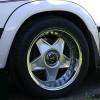| Author | Topic |
|---|

Location:
Adelaide
Registered:
June 2003
|
|
why do worn tyres have no grip and slicks have lots?
|
 Wed, 24 March 2004 09:19
Wed, 24 March 2004 09:19

|
 |
as per the title,
how come tyres with worn rubber, like not fully bald down to the lining or anything, but with allmost no tread left, how come they have less grip than tyres that have more tread.
a worn tyre has more rubber in contact with the roads surface, so wouldnt you expect it to have more grip, because that is the concept behind a slick tyre. more rubber in contact with the road means more grip, but with my tyres, 2 are pretty worn down, and 2 are still good, and the end with the worn ones has less grip and i rotated them and the same thing apply, the end with the worn ones has less grip
i dont understand how come more rubber in contact with the road reduces the grip, is it crappier rubber down low or what?
|
|
|
Location:
Brisbane
Registered:
February 2003
|
|
|

Location:
Adelaide
Registered:
June 2003
|
|
Re: why do worn tyres have no grip and slicks have lots?
|
 Wed, 24 March 2004 09:31
Wed, 24 March 2004 09:31
 
|
 |
but by that theory, woudlnt fitting wider tyres also reduce your grip,
or having a tyre with half the amount of contact patch as a normal tyre increase the grip
i still dont get it, mabye im stupid
|
|
|

Location:
Colac, Victoria
Registered:
May 2002
|
|
Re: why do worn tyres have no grip and slicks have lots?
|
 Wed, 24 March 2004 09:38
Wed, 24 March 2004 09:38
 
|
 |
|
alot could do with compounds too ?
|
|
|

Location:
Adelaide
Registered:
June 2003
|
|
Re: why do worn tyres have no grip and slicks have lots?
|
 Wed, 24 March 2004 09:45
Wed, 24 March 2004 09:45
 
|
 |
| Classique71 wrote on Wed, 24 March 2004 19:38 |
alot could do with compounds too ?
|
yeah i guess so, but i wouldve though that having a worn tyre with more rubber in contact with the ground would be similar to just having a wider tyre.
i guess the grooves must have more to do with it than just to disperse water on a wet road. like i know the design effects handling, but i woudlve thought more a larger contact patch would equate to more grip
|
|
|

Location:
UK at moment
Registered:
May 2003
|
|
Re: why do worn tyres have no grip and slicks have lots?
|
 Wed, 24 March 2004 10:56
Wed, 24 March 2004 10:56
 
|
 |
Compounds have everything to do with it 
With slicks you do a burnout to warm them up - they need to be warm. The outside of the tyre actually liquifies! You can hear it sticking to the tarmac when a decent drag car reverses after a skid.. It even leaves tracks of rubber!
|
|
|

Location:
Wahroonga
Registered:
June 2003
|
|
Re: why do worn tyres have no grip and slicks have lots?
|
 Wed, 24 March 2004 12:37
Wed, 24 March 2004 12:37
 
|
 |
Slicks also use alot different tyre set up. They use lower tyre pressure, and the tyre wall on slicks folds over itself (there are two tyre walls)and provides more surface area to the ground when first taking off and the tyre then unfolds itself providing the acceleration that would have been lost by the wheels spining.
Torque is right that the tyres need to warm up, if u take a good look the burnouts that they do at the start of the 1/4 mile they position their wheels on a puddle of water to start the burnout.
So slicks work so well because the have a much better compound and a different tyre setup than street tyres.
If anyone disagrees with me or thinks i'm wrong, plz state ur view here. I have only read a few articles on the subject and only been to the drags once, so feel free.
|
|
|

Location:
Brisbane
Registered:
May 2002
|
|
Re: why do worn tyres have no grip and slicks have lots?
|
 Thu, 25 March 2004 00:07
Thu, 25 March 2004 00:07
 
|
 |
Yes it's mostly compound. Worn street tyres have no grip because the rubber has gone hard and crappy. Slicks are uber-soft and sticky, although they also become harder and less sticky as they wear. Note that in racing classes where street tyres must be used, it's common practice to grind most of the tread off new tyres; the rubber is still new so you have just as much grip, but the smaller tread blocks don't squirm around as much.
As for the contact patch thing, the contact patch for any tyre is a function of only two factors: tyre pressure and weight. For a car with a given mass with a given tyre pressure, the surface area of the tyre's contact patch will be constant regardless of the tyre size. A wider tyre will change the shape of the contact patch (wider and shorter) but the surface area will remain the same.
|
|
|

Location:
Eskilstuna, Sweden
Registered:
May 2002
|
|
Re: why do worn tyres have no grip and slicks have lots?
|
 Thu, 25 March 2004 01:46
Thu, 25 March 2004 01:46
 
|
 |
| Norbie wrote on Thu, 25 March 2004 11:07 |
A wider tyre will change the shape of the contact patch (wider and shorter) but the surface area will remain the same.
|
Are you sure about that?.............. 
|
|
|

I supported Toymods
Location:
Epping, Sydney
Registered:
May 2002
|
|
|

Location:
c'town, NSW
Registered:
May 2002
|
|
|

Location:
melb
Registered:
May 2002
|
|
|

Location:
Adelaide
Registered:
June 2003
|
|
Re: why do worn tyres have no grip and slicks have lots?
|
 Thu, 25 March 2004 05:16
Thu, 25 March 2004 05:16
 
|
 |
| Norbie wrote on Thu, 25 March 2004 10:07 |
Yes it's mostly compound. Worn street tyres have no grip because the rubber has gone hard and crappy. Slicks are uber-soft and sticky, although they also become harder and less sticky as they wear. Note that in racing classes where street tyres must be used, it's common practice to grind most of the tread off new tyres; the rubber is still new so you have just as much grip, but the smaller tread blocks don't squirm around as much.
As for the contact patch thing, the contact patch for any tyre is a function of only two factors: tyre pressure and weight. For a car with a given mass with a given tyre pressure, the surface area of the tyre's contact patch will be constant regardless of the tyre size. A wider tyre will change the shape of the contact patch (wider and shorter) but the surface area will remain the same.
|
that still dosent explain why the worn down tyres i have have less grip than the ones with lots of tread left when they are all the same age....
and isnt a worn tyre with less gaps in the tread equivalent to a tyre that is wider?
(not trying to be difficult, im just having trouble making sense of the whole thing)
|
|
|

Location:
Brisbane
Registered:
May 2002
|
|
Re: why do worn tyres have no grip and slicks have lots?
|
 Thu, 25 March 2004 06:46
Thu, 25 March 2004 06:46
 
|
 |
| lang wrote on Thu, 25 March 2004 15:16 |
that still dosent explain why the worn down tyres i have have less grip than the ones with lots of tread left when they are all the same age....
|
It's not so much the age of the tyre, it's the heat cycling the rubber is subjected to during normal use. If tyre A has more wear than tyre B and both are the same age, it's clear that tyre A has had a harder life, ie more frequent and/or more extreme heat cycling. This is what causes the rubber to "go off" and lose its grip.
| lang wrote on Thu, 25 March 2004 15:16 |
and isnt a worn tyre with less gaps in the tread equivalent to a tyre that is wider?
|
Not sure what you mean by that...
| draven wrote on Thu, 25 March 2004 11:53 |
if that's true, why do v8 supercars/f1 cars bother with uberwide rubber?
|
I never said wider tyres weren't beneficial, I just said they don't give you a larger contact patch! There are other factors to consider, and it pretty much comes down to compound again.
A wider tyre has a shorter contact patch, which means any given point on the tyre will be in contact with the road for a shorter period of time. It also means the overall area of the tyre's contact surface is larger. What this means is you can run a softer compound without overstressing the tyre, ie overheating the rubber to the point where localised melting occurs. Melted rubber = skids = lack of traction and accelerated wear.
Of course this is oversimplifying things a great deal; tyre design and construction is an extremely complicated business these days.
|
|
|

Location:
Adelaide
Registered:
June 2003
|
|
Re: why do worn tyres have no grip and slicks have lots?
|
 Thu, 25 March 2004 08:43
Thu, 25 March 2004 08:43
 
|
 |
| Norbie wrote on Thu, 25 March 2004 16:46 |
| lang wrote on Thu, 25 March 2004 15:16 |
and isnt a worn tyre with less gaps in the tread equivalent to a tyre that is wider?
|
Not sure what you mean by that...
ie overheating the rubber to the point where localised melting occurs. Melted rubber = skids = lack of traction and accelerated wear.
|
what i was getting at is imagine the lines that follow shortly to be the contact patch of the rubber on the road.....
Tyre A: -- -- -- (normal Tyre)
Tyre B: -------- (normal Tyre with its grooves worn off)
Tyre C: -- -- -- -- (wider Tyre)
So as you can see, the normal tyre with its grooves worn out has a longer contact patch on the road, even though its not actually any wider, its contact length on the road is similar to a wider grooved tyre that still has its gaps. hope that makes sense.
but yeah i agree with your point about the rubber in the more worn tyres having had a harder life.
as for what you said about localised melting of the rubber, i had that occur when i went out on street tyres at mallala, after a few lots of 8 laps the rubber was gettings so hot that the grooves in the tread would be allmost filled in with melted rubber, eventually it got so bad it caused me to spin out, i was just taking a corner normally when all of the sudden i lost all grip basically and just went straight off on a tanget to the curve i was turning on and off the track.
|
|
|

Location:
Brisbane
Registered:
October 2002
|
|
Re: why do worn tyres have no grip and slicks have lots?
|
 Thu, 25 March 2004 09:29
Thu, 25 March 2004 09:29
 
|
 |
chalk and cheese
how long is a piece of string
why do worn tyres have no grip and slicks have lots?
ect ect
the reason drag slicks grip so well is they are VERY soft, i.e. if u pick up a normal commodore tyre and rim and thorw it at someones face u will fuck them up, if u did the same with a full sized slick u will knock them over but PROBABLY not injure them
They also run about 6-8 psi so the sidewalls "ripple" heavily when they launch, which allows them to hook up better
On launch, most group 1 drag cars probably have a contact patch of about 15-18 odd inches {approximated}, but by the end of the track it can be 12 inches of track,
| Quote: |
With slicks you do a burnout to warm them up - they need to be warm. The outside of the tyre actually liquifies! You can hear it sticking to the tarmac when a decent drag car reverses after a skid.. It even leaves tracks of rubber!
|
most of the reason they stick to the tarmac on reverse is because of a traction compound just called VHT {has a more technical name}, they spray this on the WHOLE track to help accomodate traction.
If u r at a street meet they probably wont put it down {not emuff power out of most of the cars to neccetate it}, but some times at street meets a very quick car comes out and tries to run and the run just goes to shit caus he's slipping all over the joint {thats why tony khoury's old probe hit the wall, 1600hp on an un-prepped track  } }
any car leave tracks of rubber
here is what i mean by tyrewall distortion

|
|
|

I supported Toymods
Location:
Epping, Sydney
Registered:
May 2002
|
|
Re: why do worn tyres have no grip and slicks have lots?
|
 Thu, 25 March 2004 09:39
Thu, 25 March 2004 09:39
 
|
 |
|
much appreciated... gotcha now.
|
|
|
Location:
Brisbane
Registered:
February 2003
|
|
Re: why do worn tyres have no grip and slicks have lots?
|
 Thu, 25 March 2004 10:14
Thu, 25 March 2004 10:14
 
|
 |
just to extend on what Norbie was saying..
The size of the contact patch doesn't change when choosing a wider tyre.. *at the same pressures*. It just gets shorter, ie:
|||
|||
|||
|||
||||
||||
||||
This provides better cornering because the size of the lateral contact patch is greater, giving more sideways grip
It also explains why wide tyres tramline (follow imperfections in the road), because their longitudinal grip is less than a narrow tyre which tracks nicely.
The only way to increase your contact patch is to lower the tyre pressure, as seen in all dragracing and 4WD beach driving.
|
|
|

Location:
Adelaide
Registered:
June 2003
|
|
Re: why do worn tyres have no grip and slicks have lots?
|
 Thu, 25 March 2004 10:31
Thu, 25 March 2004 10:31
 
|
 |
|
what effect does the circumference of the tyre have on the shape of the contact patch? (what happens with a larger overall rim and rubber size)
|
|
|

Location:
UK at moment
Registered:
May 2003
|
|
Re: why do worn tyres have no grip and slicks have lots?
|
 Thu, 25 March 2004 13:11
Thu, 25 March 2004 13:11
 
|
 |
Any tyre will leave tracks after a burnout, but it is a LOT greater with proper slicks - you can hear it sometimes!
I thought VHT was just sprayed the first half of the track?
I've learnt a bit from this thread - but i'm having trouble with the idea that the contact patch doesn't change, even a bit..
EG: a 175/65/15 compared to a 285/65/15 - is this not going to have more rubber in contact with the ground at all?
|
|
|

Location:
melb
Registered:
May 2002
|
|
Re: why do worn tyres have no grip and slicks have lots?
|
 Thu, 25 March 2004 15:04
Thu, 25 March 2004 15:04
 
|
 |
torque - learn this equation p = l/a
where p = pressure, l = load, a = area.
if the pressure is the same (eg 30psi), the load the same (eg 1000kg car) the area must be the same.
the original question is bad - why do worn tyres have no grip and slicks have lots?
this is a pointless question, its like comparing apples to oranges. its stupid to compare a worn out street tyre with a racing slick!!
the question should be :
seeing as racing tyres have no grooves why dont my worn tyres grip as good as when they have lots of tread? - now we can make a decent comparison.
but heres another question basically asking the same thing :
- would a slick that has been grooved have the same,less or more grip than an ungrooved slick? why?
and by grip im not talking about racing conditions,im imagining for example the start line take off where the tyres are at low temps and have not had time to heat up.
|
|
|

Location:
Adelaide
Registered:
June 2003
|
|
Re: why do worn tyres have no grip and slicks have lots?
|
 Thu, 25 March 2004 23:10
Thu, 25 March 2004 23:10
 
|
 |
| chrisss wrote on Fri, 26 March 2004 01:04 |
torque - learn this equation p = l/a
where p = pressure, l = load, a = area.
if the pressure is the same (eg 30psi), the load the same (eg 1000kg car) the area must be the same.
the original question is bad - why do worn tyres have no grip and slicks have lots?
this is a pointless question, its like comparing apples to oranges. its stupid to compare a worn out street tyre with a racing slick!!
the question should be :
seeing as racing tyres have no grooves why dont my worn tyres grip as good as when they have lots of tread? - now we can make a decent comparison.
but heres another question basically asking the same thing :
- would a slick that has been grooved have the same,less or more grip than an ungrooved slick? why?
and by grip im not talking about racing conditions,im imagining for example the start line take off where the tyres are at low temps and have not had time to heat up.
|
if you actually read the first post in this topic youd see that the title was an attempt at a vague description of what the topic contanined rather than all the bullshit ones that say "click here please reply" at least you had some idea what you were going to be looking at when you entered the thread.
if you DID actually read the first post properly, i was comparing 2 normal street tyres, one with the grooves worn off, one with a good amount of tread left. a slick was merley mentioned to help describe what the tyre was LIKE with the grooves worn off. it was never actually a discussion about the compound used. it is blantantly obvious to everyone that slicks have more grip than a street tyre. it was a reverence to the fact that no grooves are used.
| Quote: |
a worn tyre has more rubber in contact with the roads surface, so wouldnt you expect it to have more grip, because that is the concept behind a slick tyre. more rubber in contact with the road means more grip, but with my tyres, 2 are pretty worn down, and 2 are still good, and the end with the worn ones has less grip and i rotated them and the same thing apply, the end with the worn ones has less grip
|
now that youve read that properly, you will see im comparing 4 of the same kind of tyre, 2 worn and 2 not worn. i was never comparing a worn street tyre with a slick tyre.
the question wasnt bad it was the exact same question that you have so brilliantly rephrased in your post, the title of the topic was a guide to what was in the thread not the actual question.... as you would have known if you bothered to read it!
|
|
|

Location:
Brisbane
Registered:
October 2002
|
|
Re: why do worn tyres have no grip and slicks have lots?
|
 Fri, 26 March 2004 07:26
Fri, 26 March 2004 07:26
 
|
 |
| torque wrote on Thu, 25 March 2004 23:11 |
Any tyre will leave tracks after a burnout, but it is a LOT greater with proper slicks - you can hear it sometimes!
|
yes it is much greater
| Quote: |
I thought VHT was just sprayed the first half of the track?
|
some only spray half track but the big tracks {willowbank/WSID ect} spray the whole thing
|
|
|

Location:
melb
Registered:
May 2002
|
|
Re: why do worn tyres have no grip and slicks have lots?
|
 Fri, 26 March 2004 08:02
Fri, 26 March 2004 08:02
 
|
 |
settle down lang...my response was not meant to insult you...where did I actually call you anything....I knew what you were trying to ask, but there were a lot of responses crapping on about compounds - the first 3 responses mention compounds.
Im not interested in getting into a tit for tat bullshit discussion, trying to prove to people participating in this forum who is the smarter - why do I give a shit.
what I am interested in knowing is the answer to your (poorly worder) question....thats all!!!
norbi, in the 7th post, was the first to actually try and answer the underlying question.
sorry for trying to help find the answer.
|
|
|

Location:
Adelaide
Registered:
June 2003
|
|
Re: why do worn tyres have no grip and slicks have lots?
|
 Sat, 27 March 2004 00:41
Sat, 27 March 2004 00:41
 
|
 |
heh mabye i was being a bit over the top 
|
|
|

Location:
Canberra
Registered:
August 2003
|
|
Re: why do worn tyres have no grip and slicks have lots?
|
 Sun, 28 March 2004 13:52
Sun, 28 March 2004 13:52

|
 |
chris
there are so many posts about tyre compounds because that is the answer. Your average street tyre is made of a very hard rubber. hard rubber is FAR less grippy than soft rubber BUT it is VERY durable in comparison the soft rubber. lasts longer, thats what your average driver is most concerned about. SO a worn out street tyre has less grip because the rubber is old and stiff.
A slick tyre is very soft and has a shitload of grip BUT is made from very soft rubber, therefore durability suffers greatly. If you own GT3 on playstation 2 go out on a track with supersoft slicks and take a hairpin, then go get a super hard tyre and try take the same corner at the same speed.
As for comparing its surface area with that of a new street tyre its a matter of the tyres life, the more worn out one has clearly been subjected to the most abuse and life all things rubber degrades in quality through abuse. Just look at aged rubber bushings, eventually they become hard and brittle. and given a street tyre is designed to only last a specific number of kilometers most manufacturers will choose a compound that can be made cheaper to last that number of kilometers.
Long story short, road tyres are made of a hard, less grippy compund that slicks. Worn out street tyres grip less than new ones because the already less grippy rubber has begun to degrade in quality.
|
|
|